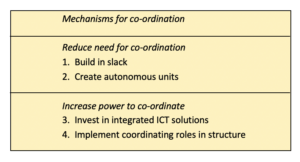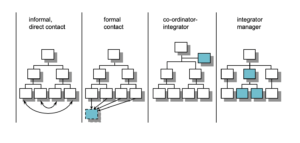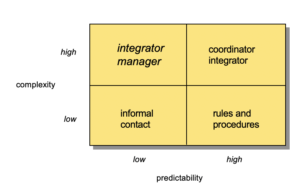Every manufacturing company has a physical goods flow. The goods flow starts moving if company staff, customers, suppliers, or logistics service providers make logistics decisions about the goods flow. How a company organizes the flow of goods contributes to realizing the company’s objectives.
Logistics impacts customer satisfaction, the company’s costs, and operating capital associated with stocks and capacities. It even influences the speed with which the company can respond to new customer wishes: new products, services, and distribution channels.
Individual customers’ demands on the product and delivery time, as well as on the service during and after delivery, are becoming stricter. At the same time, the company must pay close attention to costs and operating capital from the point of view of shareholder value. Quality and cost objectives must be simultaneously realized. Logistics is, therefore, under pressure in many companies.
Logistics is not confined to the four walls of the company. Collaboration in the market, product development, and outsourcing require intensive collaboration between companies: supply chain management. A successful supply chain demands a perfect internal logistics chain within each participating company.
Companies therefore develop an integrated logistics concept. A well-chosen balance between the logistics network, the logistics control model, the logistics ICT, and the logistics organization.
Good logistics performance demands logistics control …
It nevertheless appears time and time again that logistics coordination in companies is difficult to achieve. The decisions taken by people influence the logistics performance. These logistics decisions are taken in several, often functionally oriented departments. Such departments have their objectives. Therefore, making these individual logistics decisions does not automatically lead to products ultimately arriving at the customer with the right specifications. The division of tasks between people and departments means that coordination is continually required between the interconnected steps in the goods flow. Logistics control focuses on realizing this desired interconnection.
Logistics control is: the organization, planning, and control of the goods flow, from product development, purchasing, via manufacturing and distribution to the end customer, to satisfy customers’ needs at low cost and with controlled use of capital.
If a company has long delivery times or can afford large stocks, the company can control the steps in the goods flow more or less independently from one another. The necessity for integrated coordination is then limited. If the environmental requirements increase, the need for coordination also increases. If mutual coordination, for instance, using direct contact or telephone or email, is inadequate to realize this coordination, additional coordination mechanisms are required. Some companies then decide to centrally organize the logistics control in one department that must monitor the goods flow from a control tower. Other companies, however, choose to keep the logistics control decentralized at functional departments: manufacturing, purchasing, and sales.
The organization is a key factor for logistics control …
The logistics organization determines the level of integration with which people who make decisions approach the logistics. The logistics organization also determines the emphases and priorities in the action of the people.
The logistics organization involves:
- The introduction of several levels in logistics control.
- Distinguishing the organizational units to be controlled (for example, manufacturing and distribution units) as logistics organizational units that independently perform part of the logistics processes.
- Combining decisions for logistics control at organizational units.
- Making connections between the organizational units.
- Subdividing and connecting task areas: the activities for the logistics control are ultimately assigned to people and groups of people, and the tasks and responsibilities are determined.
Knowledge about the logistics organization is still inadequate…
A lot has been achieved in the field of logistics management. Nevertheless, knowledge about the logistics organization is still inadequate. This study aimed to produce scientific knowledge about the organization of logistics control by approaching the subject from the point of view of organizational theory and by comparing it with day-to-day practice.
The challenge of a research project performed by Walther Ploos van Amstel was to develop design models that assist logistics designers at manufacturing companies in evaluating and designing the logistics organization. The objective was achieved in four steps:
- The definition of logistics control and the decisions that involve this logistics control.
- Identifying organizational theories about organizing in general and integration/coordination in particular.
- The development of design models for the logistics organization based on organizational theories.
- The evaluation of the design models in practice by performing single and cross-case analysis.
The logistics organization is an organizational theory question and must be answered based on organizational theory principles. Organizational theory has several perspectives for examining organizations. For this study, the contingency approach has been chosen. How an organization should be designed and equipped depends upon the situation. It is precisely the limitation of employing this one approach that offers possibilities for observing and evaluating the functioning of the design models in practice.
Division of labor and coordination are the centralized organizational theory subjects for logistics control …
Organizational units arise from the division of labor: jobs, departments, offices, and divisions. The division of labor facilitates the specialization of people and resources on a particular homogenous task, so that higher effectiveness, quality, and performance efficiency can generally be achieved. Using further differentiation, differences are also created in goals, time perspectives, style of interaction, and the level of formalization of structures.
Every form of the division of labor represents a break in the coherence in a wider context. Using the division of labor, boundaries are created: between several levels in the organization and the hierarchical position of people, between jobs, departments, and disciplines, between the company and suppliers, customers and service providers, and between countries, cultures, and markets. The realization of the right logistics performance is not easy, therefore. The division of labor can lead to fairly autonomous and uncoordinated plans by and between departments and ultimately even to sub-optimal situations and poor logistics performance.
Coordination aims to restore the broken connection; how can the organizational units be forged into a single unit in a broader context?
As far as possible, the logistics control takes place in separate units of the logistics structures using well-designed tasks, adequately trained people, and regulations and procedures. To clarify the position in the organization, task and job descriptions are made, where necessary, and tasks and instructions are published for the performance of activities. The mutual coordination can then take place in advance using planning.
Increasing coherence, more severe market demands, and greater complexity require the incorporation of more and more radical coordination mechanisms that are designed to process exceptions as much as possible: permitting forms of logistics slack, creating autonomous logistics organizational units, investing in logistics ICT and the realization of horizontal and lateral relationships.
Permitting slack is undesirable from the point of view of logistics costs and benefits. Carrying the implementation of autonomous organizational units too far can reduce economies of scale, synergetic effects can be wasted, and the coherence between the organizational units can even be lost entirely. It is doubtful whether logistics ICT alone is adequate to achieve logistics control.
In the case of horizontal and lateral relationships, coordination and/or decision-making relationships are incorporated throughout the hierarchy. The emphasis shifts from a hierarchical connection to a horizontal connection between organizational units to realize rapid and improved coordination between organizational units. Horizontal and lateral relationships can be created employing informal communication, formal communication, formal teams, coordinators. and finally, the matrix organization. The implementation of these relationships places a heavier burden on the organization. Non-essential but excessive built-in mechanisms are regarded as annoying. A conscious choice is essential, therefore.
Horizontal and lateral relationships for logistics control …
The question is then how the realization of horizontal and lateral relationships, for instance, the appointment of a logistics manager, can improve logistics performance.
Suppose the organizational theory insights into the additional coordination mechanisms are applied to the organization of the logistics control. In that case, two design models can be distinguished: a decentralized and a centralized logistics organization.
Decentralized logistics organization…
The logistics decisions are decentralized with the functional departments in a decentralized logistics organization. Logistics coordination is realized through informal or formal coordination within the hierarchical structure.
In the case of informal coordination, the coordination is primarily facilitated by employing guidelines, regulations, simplified rules, tasks, procedures, and objectives. Direct, informal mutual coordination only takes place between people when exceptions occur. Also, in the case of formal coordination, the coordination is primarily facilitated by employing guidelines, regulations, simplified rules, tasks, procedures, and objectives. Additional coordination is realized by regularly bringing together people from the functional departments in particular formal structures.
Centralized logistics organization…
In the case of a centralized logistics organization, additional logistics coordination is organized within the organization structure in a logistics department. For an autonomous organizational unit, the logistics structures are coherently controlled at the goods flow level. Two emphases are possible: coordinator-integrator or integrator-manager.
The logistics department as coordinator-integrator fulfills a role that is directed towards stimulating the coordination between departments, but without the formal authority to make decisions. As a coordinating department, the logistics department as integrator-manager fulfills an integrating role with particular binding powers. The logistics department is given powers to overcome differences between departments in decision-making. The logistics department follows the implementation of the logistics planning, draws attention to abnormalities, and makes actual adjustments.
Logistics complexity and logistics predictability define the logistics organization…
In the case of low logistics complexity, it is relatively easy to make the logistics plan. The coordination can be formally or informally realized within the existing hierarchical structure: with direct mutual coordination between the functional departments or between people.
If the logistics complexity increases, considerable effort is required to (re)make the logistics plan. This demands greater effort from the departments. A logistics (staff) department can coordinate to prepare the logistics plan. The decision-making is the responsibility of the functional departments.
If the logistics predictability decreases, evaluation and adjustment are increasingly required to keep the goods flow on the right track. This means that information about the logistics execution must be compiled repeatedly, and a new logistics plan must be drawn up. When the logistics complexity is low, this causes few problems. Because the logistics complexity is low, the information is often on hand, and the consequences of decisions for the different departments are easy to keep track of. Coordination can be realized in direct, informal contact between people and ad hoc in the case of problems. If the logistics complexity increases and the logistics predictability decreases, it becomes increasingly complex to provide insight into the consequences of decisions.
Achieving an ‘optimum’ solution for the entire organization requires greater effort. In a situation with a high logistics complexity and a low logistics predictability, coordination cannot only be realized via the existing hierarchical structure and formal consultation. The logistics department not only has a coordinating role in the preparation of the plan, but also especially in the logistics control of the decision-making concerning deviations. The logistics department must be able to influence the decision-making or even have the powers to take decisions.
Confrontation with reality shows that ….
The design model for a decentralized logistics organization is suitable for situations with a low logistics complexity and a high logistics predictability. Structurally sound logistics performance can be achieved.
If there is a decentralized logistics organization in a company with a high logistics complexity and a high logistics predictability, poor logistics performance is achieved. The design model is, therefore not suitable in this case.
The question then is whether the design model is suitable for a centralized logistics organization with a high logistics complexity and a low logistics predictability. The cases show that this is not automatically the case. Three companies that decided to organize their logistics control centrally improved their logistics performance. Later on, the performance deteriorated again. However, one company decided to gradually develop towards a centralized logistics organization and was able to improve the logistics performance structurally. Therefore, the question of whether the design model is suitable for a centralized logistics organization with a high logistics complexity and a low logistics predictability, cannot be answered affirmatively just like that.
Explanations for the lack of success of a centralized logistics organization can be found in:
- The question is whether structurally sound logistics performance can be achieved in situations with a high logistics complexity and a low logistics predictability.
- The inability to maintain the attention and priority for logistics.
- The one-off centralized organization of the logistics control instead of a step-by-step approach.
- The laborious implementation of ICT.
- Not allowing logistics managers enough time to improve the logistics performance structurally.
- Not showing a structural result quickly enough or making visible the positive influence of logistics on the company’s objectives.
- Being unable to overcome resistance.
- Lack of support from the management.
- Being unable to make sufficient distinction in the distribution of logistics decisions at the goods flow and departmental level.
- Other explanations that do not form part of this study.
Further investigation is required into….
The questions for further investigation stem from five points of view:
- The coherence within the integrated logistics concept.
- The functioning of the logistics organization.
- Improving the empirical basis.
- The analysis of the issue based on other points of view from the organizational theory kaleidoscope.
- The logistics organization in the case of supply chain management.
Walther Ploos van Amstel.
Ploos van Amstel, W. (2002). Het organiseren van logistieke beheersing. [PhD-Thesis – Research and graduation internal, Vrije Universiteit Amsterdam]. Lemma.








